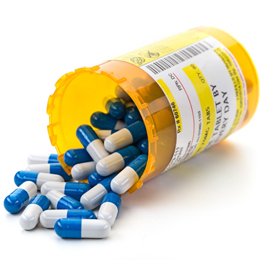
The moment before Dennis Chambers took one of his stepdad’s pain medication pills is something he’ll remember for the rest of his life.
“I read the name of the label on the bottle and Googled it—Hydromorphone,” the now 23-yearold recalls. “I started reading online forums of people who have taken it recreationally and they said it’s ‘really strong, it’s a good high, that was in the past and now I’m on heroin.’ Every time I read it I thought, ‘What’s wrong with these people?’ I had such a disconnect with the pill in front of me. I had no idea about the journey I was about to embark on.”
Chambers fell asleep within 10 minutes of taking the pill and didn’t remember anything, which was frustrating because he didn’t experience the high and euphoric sensation the online users said would happen.
“That’s a testament to how strong they are,” he says. “My mom woke me up the next morning for school and I thought to myself, ‘That was a waste.’ Everybody hyped it up and all I did was fall asleep, so I took another pill on my way to school and soon after I had the similar feeling of satisfaction and warmth [that I found] when I got drunk. It sent a wave through my body, but tenfold. I thought, ‘[Wow], this is what I’m going to do for the rest of my life.’”
That journey led the Mullica Hill resident down a dark road with many twists and turns, including a stint in rehab. He used drugs for five years graduating from the pills to heroin, but his journey ended happily. He has been clean for almost four years and most importantly, he’s alive.
Thousands more nationwide weren’t as lucky, with 1,587 drugrelated deaths in New Jersey alone in 2015—four times the number of homicides in the state and three times the number of accident fatalities that year. Locally, 343 of those residents were from Burlington, Camden and Gloucester counties—191 in Camden County alone, the highest number in the state that year and a 22 percent spike from 2014. Numbers for 2016 are still being finalized and will be available next month.
Just this past March, more than 30 pounds of fentanyl—an opioid that is up to 50 times stronger than heroin—was seized in South Jersey. In another incident that took place last month, authorities accused psychiatrist Joel B. Glass of prescribing opioids to two patients and violating the state’s Prescription Monitoring Program by not checking their prescription histories. As a result, Glass, who had a practice in Marlton, had his medical license temporarily suspended.
It’s hard to ignore these alarming numbers, and because of the dramatic spike in opioid usage, arrests and deaths across the state, Gov. Chris Christie has made the epidemic his main focus in his last year as governor. In February, he signed a bill that requires doctors to give patients an initial five-day prescription for opioid pain pills. He also helped create the ReachNJ campaign, which offers real-time prevention, treatment and recovery resources for addicts and family members, as well as state initiatives, policies, programs and services. Television commercials, radio and digital advertisements and billboards have been designed to alert the public to visit ReachNJ.gov and call 1-844-Reach-NJ to see all the help that’s available.
“Based on the call data we receive each week, the vast majority of calls are coming from the addicted individual or the concerned and frightened family member who desperately wants their son, daughter or loved ones to be connected to service,” says Gina Plotino, executive director of the NJ 2- 1-1 Partnership that powers ReachNJ. “That is what ReachNJ intended.”
Christie’s efforts in combating this issue haven’t gone unnoticed around the country, and in addition to combating this issue in New Jersey, he is an advisor in President Donald Trump’s administration to help fight this epidemic nationwide.
How it’s Evolved
Folks may think of those lost in a world of drug abuse as being hooked on hard drugs like cocaine and heroin, but of late, it’s been prescription pills, over-the-counter medication and fentanyl that people of all ages are getting involved with and users are able to hide it from almost anyone, even family members.
“The opiate epidemic has evolved in the past five years because it’s no longer an addiction that has a face,” says Erin Lawler, substance awareness coordinator at Seneca High School in Tabernacle. “The stark reality is that opiate addiction is sweeping into states, communities and homes at a speed that treatment centers and mental health professionals cannot keep up with. Ten or 15 years ago there was a face to a junkie. There was a type of person that was using heroin or cocaine; this is no longer the case.”
Chambers fits the mold Lawler mentions. He says he comes from a good family, received good grades as a student at Clearview Regional High School, lives in a prominent town and from the outside looking in; no one besides his friends knew he was taking drugs. Other people around him assumed he was living the quintessential life, including his parents.
“My mom never wanted to believe I was doing any of this,” he explains. “Her first reaction was, ‘no way.’ It goes back to the Mullica Hill personas. Everyone believes they are living the perfect life with a nice school system and everybody’s ducks are in a row, but if you dig deeper past the surface layer, you’ll see there’s a bunch of families and kids struggling day in and day out. When confronted with adversity as scary as drug addiction, their first instinct is to deny it. No one wants to talk about it.”
“Addiction is a layered and complicated beast,” Lawler adds. “An addict does not have a certain look and is not limited to a certain kind of person. As a society, we have to step up to the plate and remove the negative stigma associated with addiction. Until we allow addiction to be presented as something to not be ashamed of; we are deterring friends, family members and co-workers from receiving treatment. Addicts are in our workplace, neighborhoods and sometimes within our own homes. They are not bad people; they’re simply making bad choices that are out of their control. Treatment is critical to the recovery process and it is something one cannot do alone.”
Who’s to Blame?
According to Dr. Michael Shore, an addictions specialist in Cherry Hill, the opioid epidemic started 15 to 20 years ago “when it was a big push to be more aggressive in treating pain.
“Back then, pain was probably undertreated,” he says. “Unfortunately, we weren’t taught to screen patients for risk factors that might leave them for addiction and we were also taught that it was OK to treat chronic non-malignant pain (non-cancer pain) for longterm treatment with opioids. The pharmaceutical companies within health matters were very aggressively pushing these new treatments and new medications, encouraging us to be on board.”
And the $1 billion pharmaceutical industry championing these opioids is partly to blame, says Lawler.
“We have been saturated and hit over the head a million times with, ‘pills are the answer,’” she explains. “The pharmaceutical industry profits tremendously when medication is prescribed. They are pushing a drug that is essentially heroin in a pill. Opiates can have medical benefits, no doubt, but we have been indoctrinated to think any pain justifies popping an opiate and this is dangerous, life-threatening thinking.”
On a Mission
Patty DiRenzo has been a woman on a mission since Sept. 23, 2010, the day her son Sal Marchese died of a heroin overdose. Sadness, anger and confusion followed his death, and she thinks there’s a chance he would be alive today if the individuals around him called 9-1-1 for help. They didn’t out of fear they would be reprimanded, and he was essentially left to die.
“I was baffled someone could leave someone to die and not call for help,” the Blackwood resident recalls. “I made it a point to do something about it; I guess that was part of my healing and grieving process.”
She started making calls to various organizations, telling her story in hopes someone would listen. The Drug Policy Alliance—the nation’s leading organization promoting drug policies that are grounded in science, compassion, health and human rights—was receptive and told her at the time that 9-1-1 legislation was in place in other states, but not New Jersey. They asked if she wanted to join them and be an advocate working toward similar legislation in the state, and she didn’t have to think twice. She sent her story to as many influential people she could and made it her goal to see it become a reality.
“I made it my whole life, I was literally obsessed with that legislation,” DiRenzo says. “I wasn’t going to give up until it passed. I did everything I could—I wrote letters to editors of newspapers, every senator, assemblyman. ... I reached out to anybody that would hear me.”
Gov. Christie, whom she says she wrote to once a week, heard her. Legislation, which he originally vetoed the first time, was passed in May 2013 and is now known as The Overdose Prevention Act, allowing individuals to report drug overdoses without the fear of being arrested. Instead of viewing the individual as a criminal, one who overdoses is viewed as a person who needs immediate medical attention.
“He told me, ‘Your letters are one of the reasons why I signed this bill,’” DiRenzo recalls. “As a mother, saving other kids’ lives is what I wanted to do. I used all my sick and vacation days at work and spent a lot of time in Trenton devoting time toward that legislation, and it paid off.”
Gregg Wolfe was another parent devoted to making a change in the wake of his son, Justin’s death. The Voorhees resident and Eastern Regional High School graduate was a junior at Temple University when he died of a heroin overdose on Dec. 19, 2012. According to Wolfe, Justin’s doctors knew he was using heroin at the time, but not Wolfe because of HIPAA regulations.
“My son was 21 when he signed the HIPAA form and he was protected, but the problem was, when you are dealing with a life-threatening drug and the doctor knows you are doing heroin, the parents should know, no matter what age,” Wolfe says.
He wrote to former President Barack Obama and was contacted by Washington, D.C. to testify before the Oversight and Investigation Subcommittee along with other grieving parents, and legislation for the Helping Families in Mental Health Crisis Act was passed.
“People with mental disorders as well as life-threatening instances that doctors are aware of now can contact immediate parents and family members,” he says.
Wolfe didn’t stop there. He created Squash the Secret and JustinFor- Justice.org, both organizations that bring awareness and education to parents in the community about the hidden dangers of heroin/opiate abuse. He also joined Jewish Family Center Services heroin addiction program, Right In Our Backyard. The program has a similar mission, and started with the help of the Cherry Hill Police Department after Capt. Amy Winters and fellow police officers noticed an uptick in drug activity and arrests a few years ago.
Right In Our Backyard consists of Winters, fellow officers, addiction specialists, recovering addicts, Wolfe and other parents who’ve lost loved ones to drugs. “Our mission is to educate as many people as we can and not be afraid to talk about it,” says Winters.
They travel to various communities, including the Shore and Baltimore, talking about their experiences and educate not just the youth, but adults who have very little awareness on the subject, if any, just like Wolfe had before his son passed.
“What I did not realize was how parents haven’t been educated or have any awareness, including myself,” Wolfe explains. “Like I tell people when I speak, it might not happen to your child, but this is for your grandkids, your aunts, cousins, nephews and nieces, close friends and friends of friends. It’s a snowball effect.”
In an additional effort to promote addiction awareness and education, Camden County Freeholders, along with various law enforcement officials, formed The Camden County Addiction Awareness Task Force in 2014. They also provide every police station in the county with Narcan, a heroin reversal drug that can potentially save the life of someone who is experiencing an overdose. There have been 1,757 overdoses in Camden County since 2014 and 284 lives have been saved after Narcan was administered.
“Our main objectives of the task force early on were to make sure each police department had Narcan and the members were properly trained in [how to use it],” Freeholder Director Louis Cappelli, Jr. says. “This is a relatively recent occurrence and now that every department is equipped and trained, we’re going to see more and more saved lives.”
The task force also supplies the Black White Horse Pike School District—Highland Regional High School, Timber Creek Regional High School, Triton Regional High School— with Narcan, making it one of the first school districts in South Jersey to have the reversal drug available.
Gloucester County police departments have also used Narcan since 2014 and saved more than 350 lives. Kennedy Health and Inspira Health Network started providing the lifesaving drug at no cost to the police departments since 2015, and last month signed a twoyear agreement that allows them to continue supplying the departments.
Both health systems took it a step further by working with the Gloucester County Prosecutor’s Office and recovery coaches from City of Angels, a nonprofit addiction recovery program based in Hamilton. Patients who agree to seek addiction treatment are teamed up with a coach who will provide them addiction treatment resources.
Is it a Disease?
The debate of addiction being labeled as a disease has been ongoing for years. Some argue that the individual makes the decision to use drugs, but according to Shore, studies confirm addiction is in fact a disease, even though it is not widely treated as one.
“Traditionally, it has been a bias and a stigma that it’s a selfinflicted condition, and people like Nancy Reagan used to say, ‘Just say no,’” he says. “Then, for a long time, a lot of this addiction was concentrated in the inner city among people of color [making it] easier for white suburbs in the middle class to see it as somebody else’s problem. What we do see, and this has been demonstrated repeatedly with brain imaging studies and other scientific inquiries and endeavors, is changes in the brain chemistry and in the brain structure with repeated use. At that point, it becomes a disease.”
“The insurance companies don’t see it as a disease,” DiRenzo says. “Anytime Sal called for help, he was told he didn’t meet the criteria to enter treatment and he had to withdraw first before they would consider admitting him. Withdraw is ridiculous to do on their own; he needed help.” And Cappelli says opioid addiction doesn’t receive nearly as much attention as other diseases such as diabetes, heart disease and the recent outbreak of the Zika virus. “If the Zika virus killed 55,000 people, we’d be paying a lot more attention to the virus,” he says. “Every year, addiction kills at least 55,000 people. We should be paying attention just as though it was Ebola or any other disease.”
Never Forgotten
Justin Wolfe would have turned 26 on June 11, and to honor and celebrate his life, Gregg Wolfe and JFCS will celebrate Justin’s birthday with the “5th Anniversary Right In Our Backyard Opiate/Heroin Benefit in Memory of Justin Wolfe.” The event is June 13 from 6 to 9 p.m. at The Mansion in Voorhees and all proceeds will go directly to the Right In Our Backyard program, which will help Wolfe and others involved to continue spreading awareness in the South Jersey community and beyond, and hopefully prevent at least one life from being lost.
“I’m very strong-willed as far as spreading the word and not being ashamed of it,” he says. “No parent should ever lose their child in any way, shape or form, no matter what the disease is.”
Winters concurs that being proactive can save lives, especially for the youth that don’t see the dangerous downward spiral from the onset.
“We found so many kids that said, ‘I would never do heroin, I don’t need it,’ and they just tried pills, but they didn’t associate the consequences of pills,” Winters says. “They think because it’s legally prescribed at [a pharmacy], they didn’t associate any harm in it and don’t understand how it effects the brain. Then they start doing heroin and it leads to something else.”
Published (and copyrighted) in South Jersey Magazine, Volume 14, Issue 3 (June, 2017).
For more info on South Jersey Magazine, click here.
To subscribe to South Jersey Magazine, click here.
To advertise in South Jersey Magazine, click here.












